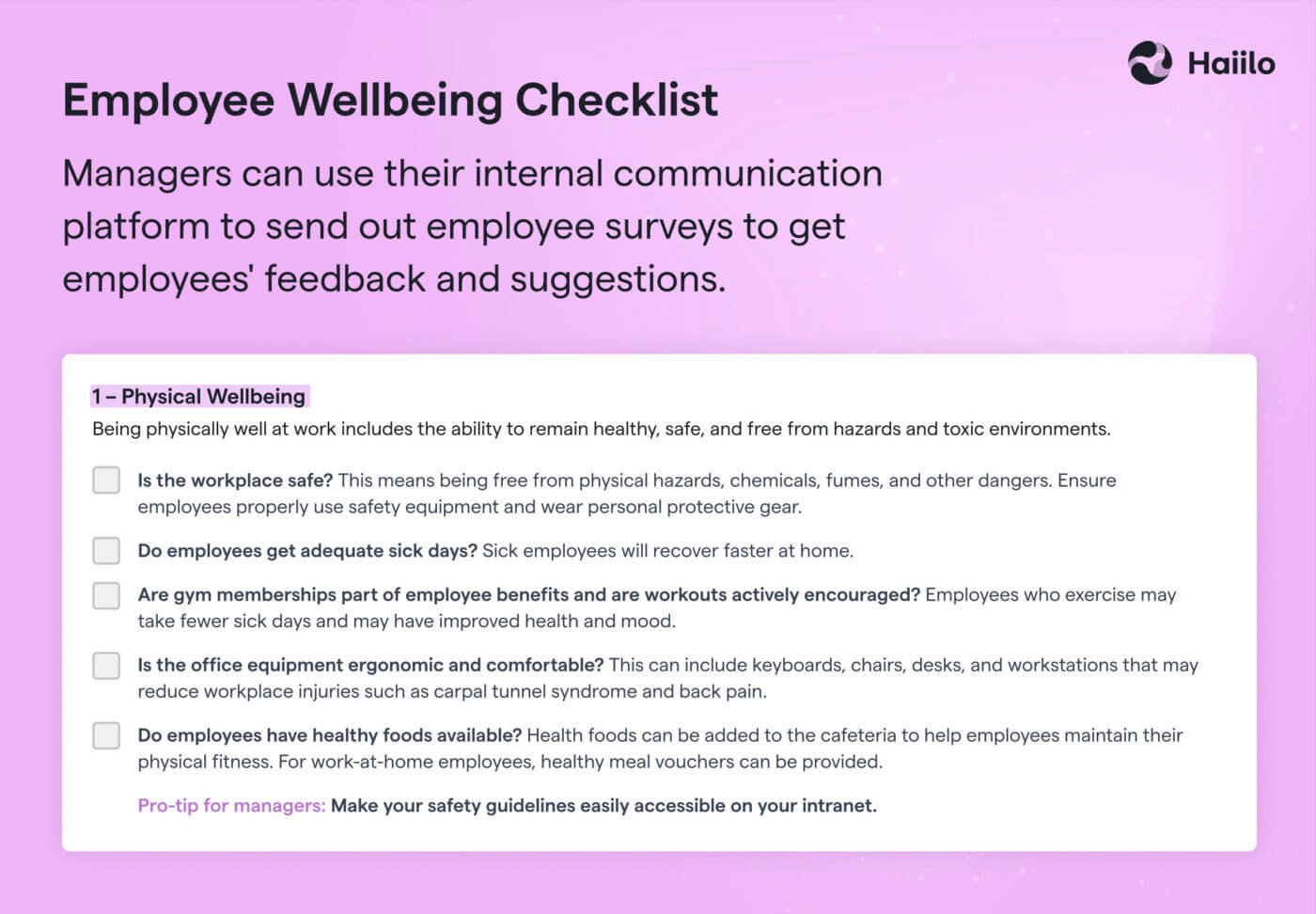In the first year of my Master’s studies in Intercultural Encounters, one professor would always ask students his signature trick question: So how do you define culture?
Why is it a trick question? Because there’s no one universally right answer to it. The concept of culture is so complex, it has so many levels to it, and can be approached from so many different angles. Naturally, students were lost when faced with this question.
Similarly, many companies are completely lost when it comes to Diversity & Inclusion in the workplace. Not necessarily because they don’t care about the cause — they are simply asking the wrong questions. To ask the right questions, we need to reframe the problem. As Glenn Llopis puts it, “when it comes to Diversity and Inclusion, the problem starts with using the word “problem.” Too many organizations view improving Diversity and Inclusion as a problem, as a challenge that needs to be solved once and for all. Instead, D&I should be about opportunity — a continuous growth process.
Get the right IC platform to support your diversity and inclusion initiatives
🤓 Want to learn more about D&I initiatives? Check out our article, Diversity and Inclusion in the Workplace: Importance and 7 Best Practices!
How to kick off this process? According to Damien Hooper-Campbell, Chief Diversity Officer at Zoom, it starts with a conversation. Empathic and transparent communications are the cornerstone of excellent employee experience built around equity, respect, and a sense of belonging. Internal comms teams play a central role in creating this kind of experience.

🎧 Tune in to The Comms Shift Podcast with guest star Jill Christensen. In this episode, we are focusing on the matters of transparency and authenticity of internal communications. Save it to your must-listen podcast list.
There is a ton of material proving the benefits of a culturally diverse and inclusive working environment. Take, for example, articles from Haiilo, Josh Bersin, Interact, Scientific American or studies made by HBR, Culture Amp, or Deloitte.
But I’m writing this not to persuade you that D&I is essential for business, that’s a given fact in 2022. The purpose of this long read is to help internal comms professionals embrace Diversity and Inclusion as one of the areas where we can make a direct and meaningful impact. Regardless if your company has an advanced D&I program with a dedicated team in place or not — the internal communications function should be the authentic, outspoken voice and reliable ally for every employee.
By no means, I consider myself an expert in this field. For that reason, I asked for help — I reached out to 10 internal comms and D&I professionals for their advice. I tried to pack these insights into three actionable areas where you can start improving your Diversity and Inclusion approach immediately. So let’s dive straight in! 👇
The voice of the voiceless. How can internal comms facilitate dialogue and build understanding about a topic they don’t necessarily ‘own’?
What happens when companies view Diversity and Inclusion as a problem and try to fix it? Usually, they allocate some budget from Corporate Social Responsibility, hire a dedicated champion or an agency, launch a series of very tactical inclusion initiatives, check the compliance boxes, and expect to be listed in Fortune’s 100 Best Workplaces for Diversity. No wonder such D&I campaigns usually fail.
What experts are unanimous about is that Diversity & Inclusion is not a “project”. It’s an ongoing effort that has to involve everyone. You might have a dedicated D&I team or not — every employee in your organization needs to be part of the continuous learning and change process. So what’s the role of internal comms in this process? — Facilitation and storytelling. Let’s hear out the experts’ practical advice.
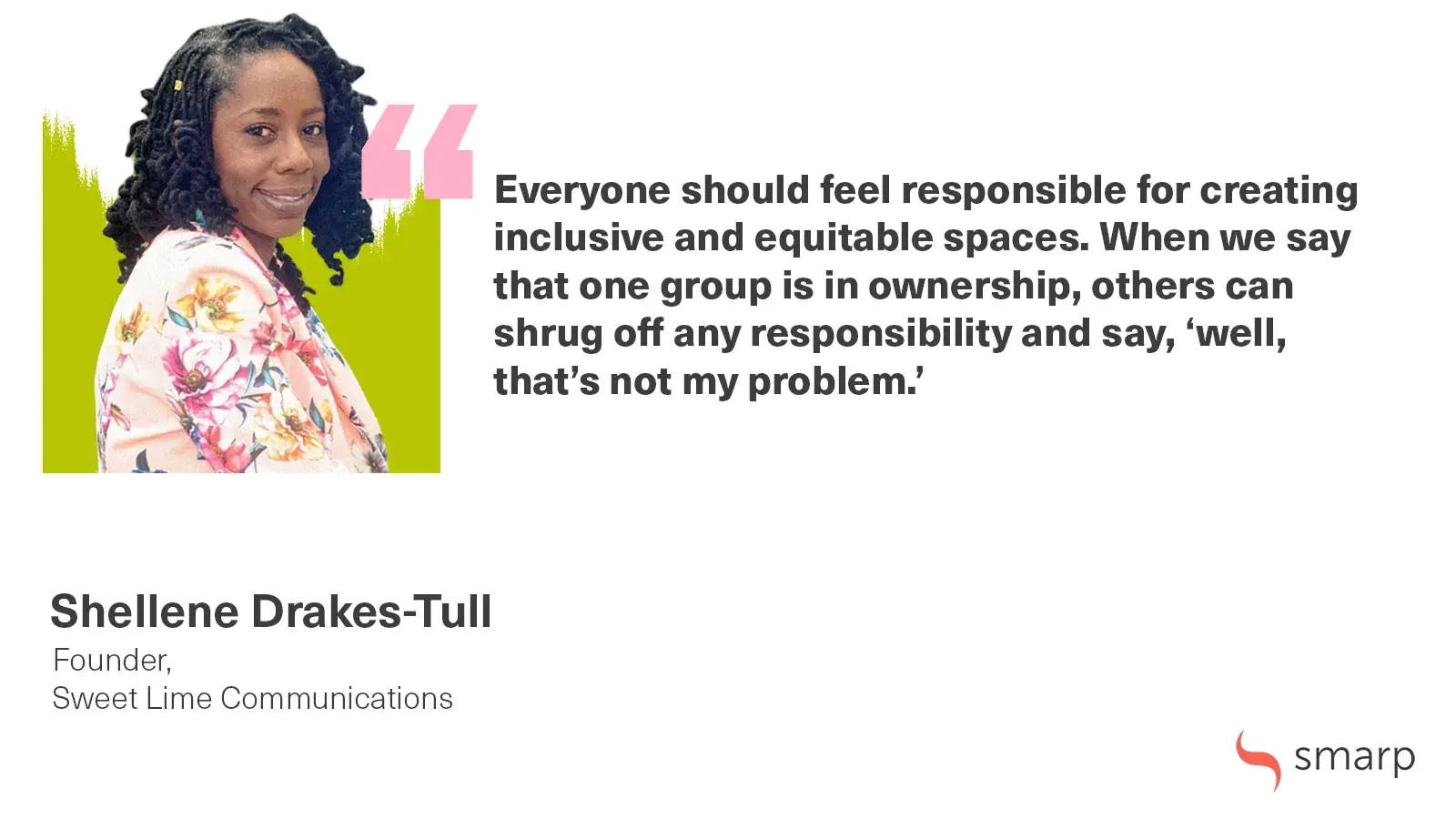
“Have weekly pools about the inclusion level in the company such as asking questions related to belonging, employee experience, leadership, and empathy level. There’s no reason why this data shouldn’t be transparent and public for everybody on e.g. the intranet. It thereby also makes everybody accountable for ensuring an inclusive working environment. That is easily a role that internal comms can facilitate and thereby also be a data mirror for the entire organization and not just the voice of management,” suggests Helene Aagaard, CEO & Partner at Diversity Factor.
Priyanka Banerjee, Diversity & Inclusion Coach at BusinessWiz, suggests these three steps for IC teams to build understanding around D&I:
“Regularly communicate the company values to all the employees (always use inclusive language). Let the employees know that D&I are at the core of the company. This already creates more awareness and possible discussions around it.
Share positive stories of your diverse workforce within the organization. This helps employees see that the company gives a fair opportunity to people from various backgrounds and intersectionality to grow and succeed.
Ensure that your internal communication tool is a safe space for employees to share their thoughts openly. It is your role to create a bully-free space. Listen, observe, and ask questions to make your platform more inclusive.”
On the latter point, we have so many great examples from companies using Haiilo as this kind of safe space for employees to speak up. It’s common for organizations to create dedicated channels where employees can share their stories and have open, less formal discussions. Our data shows that this kind of content, genuine and personal, is the most engaging for employees regardless of industry, location, or roles. Get in touch if you want to learn more about using Haiilo for authentic and inclusive communications.
Talking about sharing stories, Russell Norton, Head of client experience at scarlettabbott, says that the most important role IC teams can play to facilitate dialogue is as storytellers. “It’s not the job of an IC team to write policies or change culture – that’s up to HR and leadership to implement. It’s IC’s job to listen to diverse people in their organization and capture their lived experiences as stories that can be published internally. Ultimately, the purpose is to build empathy among the people that can influence change – in the hope that they will take action. For this reason, it’s really important that we don’t sugarcoat the stories we hear. If minority individuals are saying that discrimination exists then it is our job to listen without prejudice and present that story as their truth – something that’s not open for debate. If it makes for hard reading, good. Let that discomfort be the motivation to do something for the positive.”
Russ also has a brilliant series of short videos where he talks through how D&I and internal comms overlap, and how IC teams can best communicate diversity and inclusion in their organizations. Make sure to check those out.
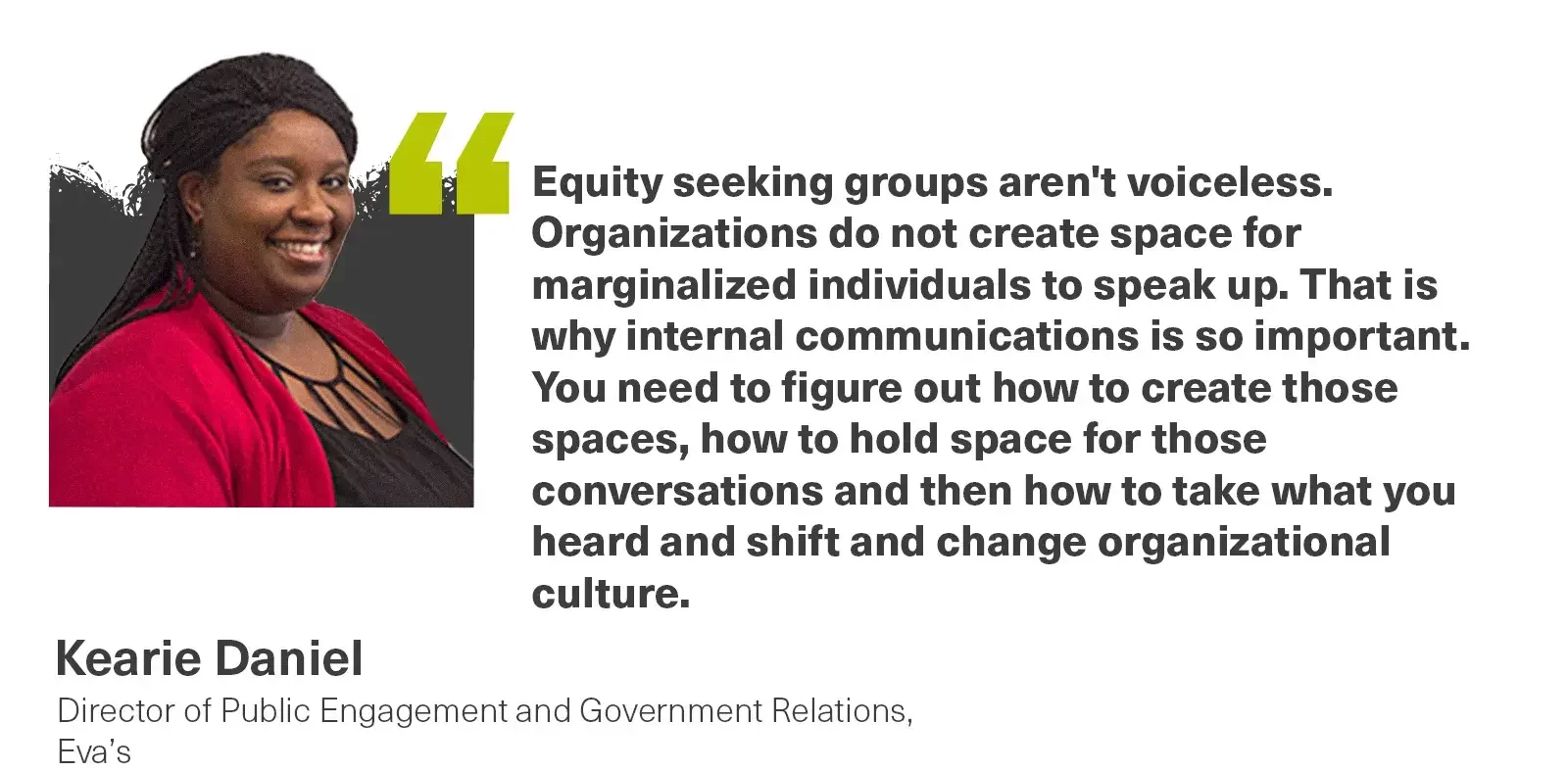
The culture of Equity & Diversity. How can we influence the employee experience to be more inclusive and representative?
I’m sure you must have seen the picture explaining the difference between equality and equity and why it matters. But I find it important to clarify why we are talking about equity rather than equality in the workplace. I’ll do it with the help of Merriam-Webster and the picture mentioned above.
Equitable — dealing fairly and equally with all concerned.
Equal — of the same measure, quantity, amount, or number as another.
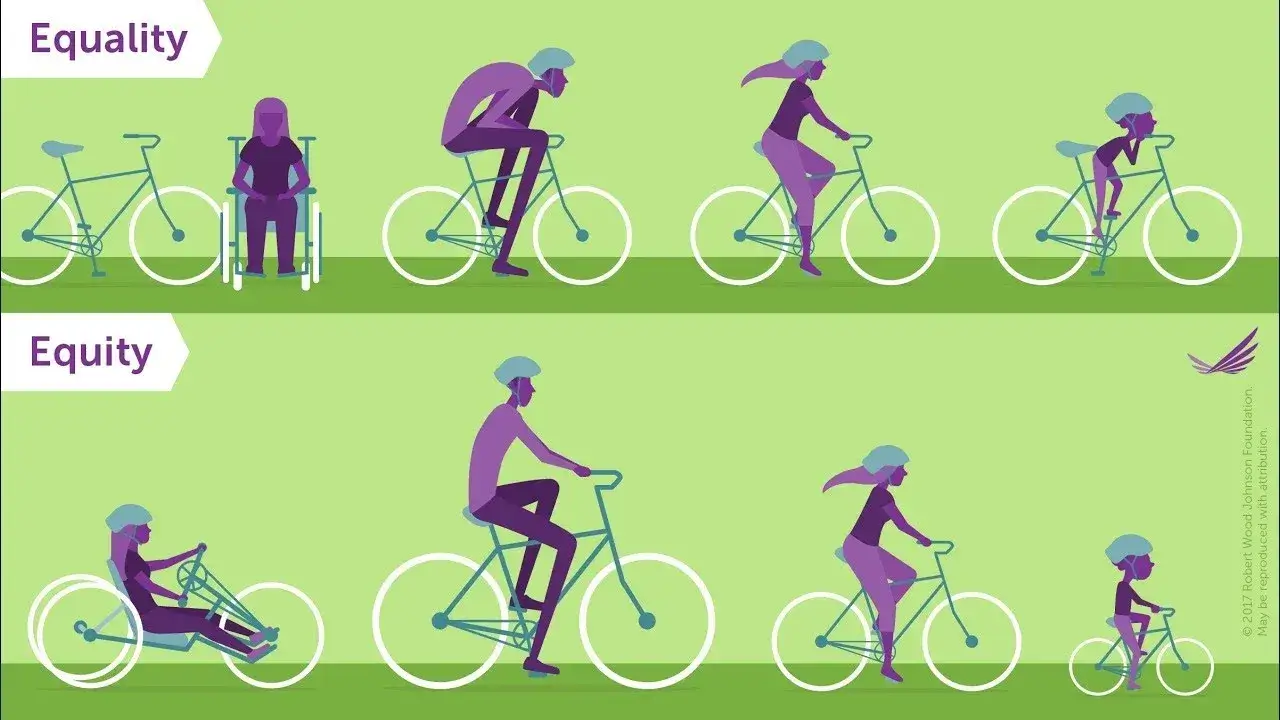
“Diversity is meaningless and so is inclusion if the organization is not equitable”, continues Kearie Daniel. “You can have an organization that is diverse and full of Black, Brown, queer or trans people…it’ll look great on your website, but having diversity and including people at the table, doesn’t mean there is equity. If Black people in your organization don’t feel they can speak up about racism because they will be sidelined, or they will experience passive aggression, or they’ll be left out of meetings or decision making, then your organization isn’t equitable and all the diversity and inclusion in the world won’t make it so.”
How can we make internal communications more equitable? “Speak with the BIPOC and underrepresented groups in the organization — what are they asking for? What are their needs? Do they feel comfortable sharing with you? This is the first step to being open and listening to understand — not to defend. Internal communications should be a tool to build a culture that encourages open and honest conversations, leading to better outcomes for everyone,” says Shellene Drakes-Tull, Founder of Sweet Lime Communications.

Daria Pritup, Project Manager at Miltton Sparks, points out that the principle of equity is not always welcomed with open arms in the workplace as some groups perceive equity as the opposite of fair. “We have been brought up to think that equality (equal opportunity, the same level of support for everyone) is the key to happiness and success, and so equity (varying levels of support based on needs) feels unfair. To be more comfortable with equity, we must be open to the experience of others and the challenges they face, learn about the way we create culture and culture creates us as well as allow ourselves to feel uncomfortable and grow.”
“Inclusion is a choice. It’s an active decision to do something for the benefit of others,” says Russell Norton. “The golden rule asks you to treat others as you’d like to be treated, while the platinum rule suggests you treat others the way they want to be treated. So what IC teams can do is work with employee resource groups and diverse individuals to gather those recommendations and suggestions of ways of working that are more inclusive for them. Gathering these together creates an ultimate guide for line managers and leaders to work with the full range of people in their teams.”
Practical advice. How can we make internal communications more inclusive?
“Words are powerful. As internal word distributors, we can unintentionally do a lot of good or a lot of bad with our words,” points out Betsy Jorgensen, Internal Communication Manager at Workfront. “Build strong relationships with a diverse group of employee voices and make a habit of getting fresh pairs of eyes on all your communications, no matter the subject matter. Lean on your employee resource groups. Learn to love feedback and always be amenable to change.”
“Constantly analyze the language used,” adds Helene Aagaard. “Is it traditional masculine or feminine? So much of our culture — also in companies — is tied to the formal and informal language, we use. Internal Communications’ task is to set a standard and The norm for inclusive language that is neutral and includes every person in the organization, no matter their gender, ethnicity, sexuality, age, and so forth.”
“The smallest steps are sometimes the most impactful,” suggests Daria Pritup. “How are people being referred to in your organization? Do you assign gender to your employees? Are you being mindful of languages they speak? Do the more senior employees in your company always take the lead in conversation and are junior employees expected to pour the coffee? How do your company’s values resonate with those who are not in the majority? Continuously improve your knowledge on the topic. I can recommend resource bank from Inklusiiv to start with.”
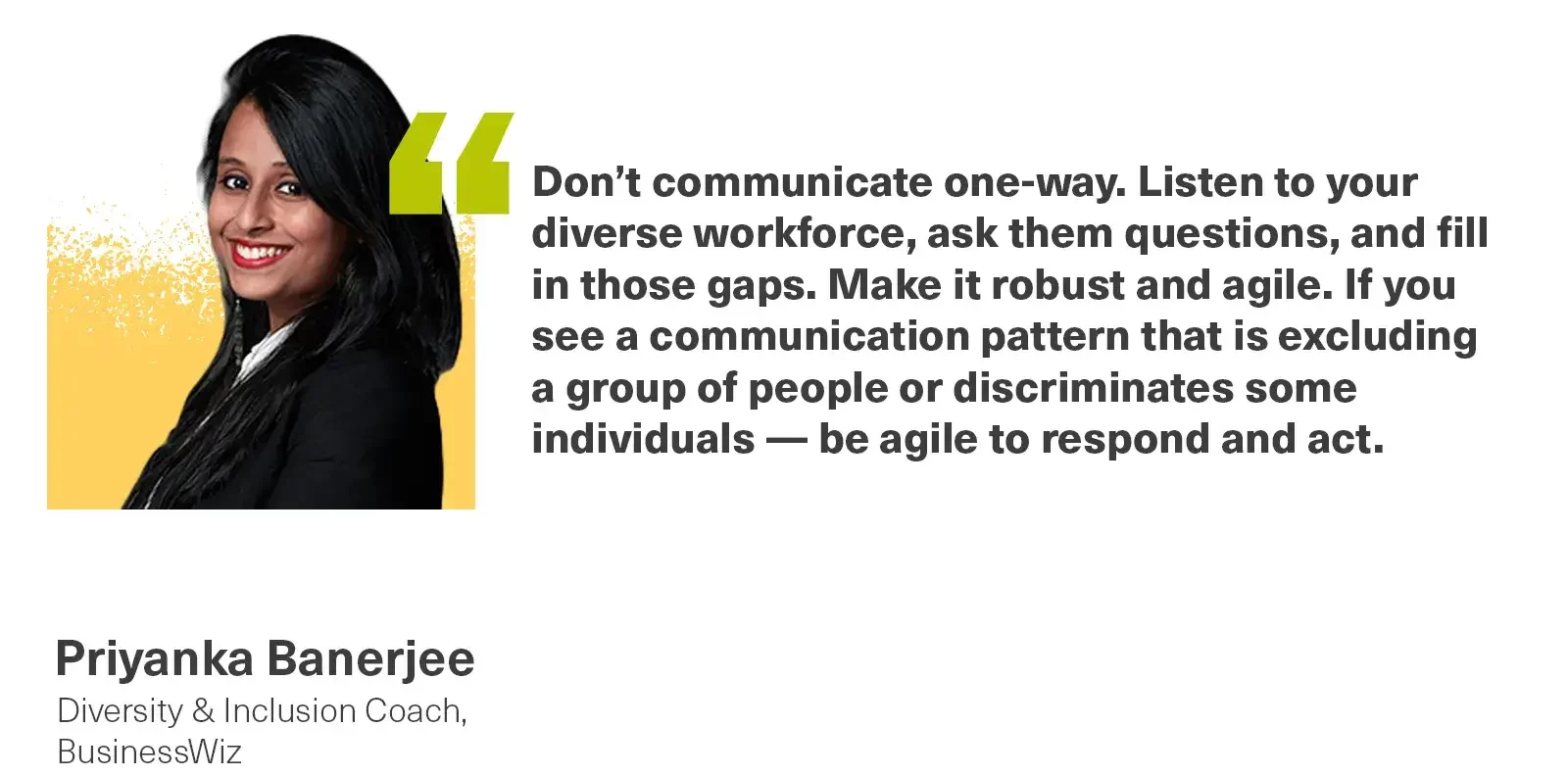
Jade Fosberry, Communications Manager – Inclusion, Diversity & Wellbeing at Deloitte Australia, reminds us how important it is to ensure that D&I has a seat at the table when developing internal comms strategies. Here are two key things Jade wants you to consider when developing your next comms strategy:
“Actively share information – Consistently share and seed D&I initiatives, recognize days of significance across the D&I community, clearly share support and resources, and consistently share updates in terms of what the organization is doing to drive the D&I strategy and agenda (and importantly, what this means for employees).
Messaging and language – Ensure inclusivity is a consideration, by actively sharing experiences from a diverse group (e.g. ages, cultures, different family make-up) and ensure the information we’re sharing is easy to find, access and understand.”
Final Notes
First of all, I want to personally thank all the contributors for sharing their valuable input for this piece. Every expert featured in this post offered a unique and inspiring perspective on this super relevant topic. It’s a pleasure to learn from you and support knowledge sharing within the comms community! 🙌
Secondly, I want to thank you, the reader, for getting this far. 💪 I know it was a long read, but I hope it was an insightful one for you. We’ve got some brilliant strategic and tactical advice from the experts here. Still, the cornerstone of equity and inclusion in any organization is a conversation, a safe space for people to express themselves and accept others. In order to #SpeakUpforInclusion, we need to be able to speak about inclusion freely and respectfully. If you’d like to continue this conversation or maybe share your thoughts in the upcoming posts — feel free to follow Haiilo, me, and the featured experts on LinkedIn.
To finish on an emotional note, let me share this short clip from RBC on having an honest conversation about inclusion.




